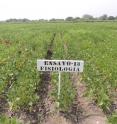Characteristics improving bean resistance to drought identified
The common bean (Phaseolus vulgaris L.) is the most important food legume in the tropics. It is an inexpensive source of proteins and minerals for almost 400 million people, mainly from Africa and Latin America. It is generally cultivated by small farmers and subject to conditions limiting their productivity. Drought affects 60% of bean crops around the world and can cause from 10% in productivity losses to a total of 100% in some cases. Researchers from the Universitat Autònoma de Barcelona and the Bean Programme at the International Center for Tropical Agriculture (CIAT) in Colombia have identified drought-resistant genotypes and the morpho-physiological characteristics related to this resistance. The experiments were conducted in Palmira, Colombia, from June to September in 2012 and 2013, and the results were recently published in Frontiers in Plant Science.
For researcher at the UAB Plant Physiology Laboratory and the International Centre for Tropical Agriculture José Arnulfo Polanía, "the experiments demonstrate that there is no dominant morph-physiological characteristic but rather a strategic combination of several characteristics which confers this resistance to drought onto specific varieties of beans". Polanía adds that "we determined which specific characteristics belonged to each area, depending on whether or not the land retained moisture and whether the droughts were intermittent or ongoing".
The study has revealed this strategic combination of characteristics, the key to succeeding in the genetic improvement of drought resistance. After evaluating 36 advanced bean lines, obtained by crossing different varieties, and taking into account the results of different parameters related to the use of water, growth and production, the lines of drought-resistant beans were classified into two groups: water "savers" and "spenders".
The "water saver" genotypes were identified for having several morpho-physiological characteristics which allow them to save water: less opening of the stomas, small leaves, moderate growth, and efficiency in remobilising carbon from the leaves and stems to the formation of sheath and grain. These genotypes correspond to the bean lines SER 16, ALB 60, ALB 6, BFS 10, BFS 29 and G40001, suitable for cultivation in semi-arid regions where extreme droughts are common and the land does not retain much moisture, as can be found in areas of Central America, Africa and the south of Mexico.
In contrast, the "water spender" genotypes include a system of deep roots which maximise water extraction, allowing them to grow more, combined with an efficient remobilisation of their reserves through the stem and leaves to the formation of sheath and grains, thus producing more grain even under stressful drought conditions. These correspond to the lines NCB 280, NCB 226, SEN 56, SCR 2, SCR 16, SMC 141, RCB 593 and BFS 67, and are appropriate for areas with intermittent droughts, on soils which can retain moisture. These areas correspond to Central America, South America and Africa.
Source: Universitat Autonoma de Barcelona
Other sources
- Characteristics improving bean resistance to drought identifiedfrom PhysorgTue, 5 Jul 2016, 18:01:43 UTC
- Characteristics improving bean resistance to drought identifiedfrom Science BlogTue, 5 Jul 2016, 17:31:42 UTC
- Characteristics improving bean resistance to drought identifiedfrom Science DailyTue, 5 Jul 2016, 17:01:11 UTC
